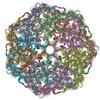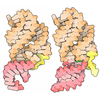+ Open data
Open data
- Basic information
Basic information
| Entry | Database: PDB / ID: 9mcw | |||||||||||||||
|---|---|---|---|---|---|---|---|---|---|---|---|---|---|---|---|---|
| Title | OLE RNA dimer (Clostridium acetobutylicum) | |||||||||||||||
 Components Components | OLE RNA dimer | |||||||||||||||
 Keywords Keywords | RNA / OLE / ncRNA | |||||||||||||||
| Function / homology | : / RNA / RNA (> 10) / RNA (> 100) Function and homology information Function and homology information | |||||||||||||||
| Biological species |  Clostridium acetobutylicum ATCC 824 (bacteria) Clostridium acetobutylicum ATCC 824 (bacteria) | |||||||||||||||
| Method | ELECTRON MICROSCOPY / single particle reconstruction / cryo EM / Resolution: 2.9 Å | |||||||||||||||
 Authors Authors | Kretsch, R.C. / Wu, Y. / Das, R. / Chiu, W. | |||||||||||||||
| Funding support |  United States, 4items United States, 4items
| |||||||||||||||
 Citation Citation |  Journal: Nature / Year: 2025 Journal: Nature / Year: 2025Title: Naturally ornate RNA-only complexes revealed by cryo-EM. Authors: Rachael C Kretsch / Yuan Wu / Svetlana A Shabalina / Hyunbin Lee / Grace Nye / Eugene V Koonin / Alex Gao / Wah Chiu / Rhiju Das /  Abstract: The structures of natural RNAs remain poorly characterized and may hold numerous surprises. Here we report three-dimensional structures of three large ornate bacterial RNAs using cryo-electron ...The structures of natural RNAs remain poorly characterized and may hold numerous surprises. Here we report three-dimensional structures of three large ornate bacterial RNAs using cryo-electron microscopy (cryo-EM). GOLLD (Giant, Ornate, Lake- and Lactobacillales-Derived), ROOL (Rumen-Originating, Ornate, Large) and OLE (Ornate Large Extremophilic) RNAs form homo-oligomeric complexes whose stoichiometries are retained at lower concentrations than measured in cells. OLE RNA forms a dimeric complex with long co-axial pipes spanning two monomers. Both GOLLD and ROOL form distinct RNA-only multimeric nanocages with diameters larger than the ribosome, each empty except for a disordered loop. Extensive intramolecular and intermolecular A-minor interactions, kissing loops, an unusual A-A helix and other interactions stabilize the three complexes. Sequence covariation analysis of these large RNAs reveals evolutionary conservation of intermolecular interactions, supporting the biological importance of large, ornate RNA quaternary structures that can assemble without any involvement of proteins. #1:  Journal: Biorxiv / Year: 2024 Journal: Biorxiv / Year: 2024Title: Naturally ornate RNA-only complexes revealed by cryo-EM Authors: Kretsch, R.C. / Wu, Y. / Shabalina, S.A. / Lee, H. / Nye, G. / Koonin, E.V. / Gao, A. / Chiu, W. / Das, R. | |||||||||||||||
| History |
|
- Structure visualization
Structure visualization
| Structure viewer | Molecule:  Molmil Molmil Jmol/JSmol Jmol/JSmol |
|---|
- Downloads & links
Downloads & links
- Download
Download
| PDBx/mmCIF format |  9mcw.cif.gz 9mcw.cif.gz | 311 KB | Display |  PDBx/mmCIF format PDBx/mmCIF format |
|---|---|---|---|---|
| PDB format |  pdb9mcw.ent.gz pdb9mcw.ent.gz | 225.6 KB | Display |  PDB format PDB format |
| PDBx/mmJSON format |  9mcw.json.gz 9mcw.json.gz | Tree view |  PDBx/mmJSON format PDBx/mmJSON format | |
| Others |  Other downloads Other downloads |
-Validation report
| Summary document |  9mcw_validation.pdf.gz 9mcw_validation.pdf.gz | 1.2 MB | Display |  wwPDB validaton report wwPDB validaton report |
|---|---|---|---|---|
| Full document |  9mcw_full_validation.pdf.gz 9mcw_full_validation.pdf.gz | 1.2 MB | Display | |
| Data in XML |  9mcw_validation.xml.gz 9mcw_validation.xml.gz | 32.2 KB | Display | |
| Data in CIF |  9mcw_validation.cif.gz 9mcw_validation.cif.gz | 48.5 KB | Display | |
| Arichive directory |  https://data.pdbj.org/pub/pdb/validation_reports/mc/9mcw https://data.pdbj.org/pub/pdb/validation_reports/mc/9mcw ftp://data.pdbj.org/pub/pdb/validation_reports/mc/9mcw ftp://data.pdbj.org/pub/pdb/validation_reports/mc/9mcw | HTTPS FTP |
-Related structure data
| Related structure data |  48163MC  9elyC  9mdsC  9meeC C: citing same article ( M: map data used to model this data |
|---|---|
| Similar structure data | Similarity search - Function & homology  F&H Search F&H Search |
- Links
Links
- Assembly
Assembly
| Deposited unit | 
|
|---|---|
| 1 |
|
- Components
Components
| #1: RNA chain | Mass: 186321.078 Da / Num. of mol.: 2 / Source method: obtained synthetically Source: (synth.)  Clostridium acetobutylicum ATCC 824 (bacteria) Clostridium acetobutylicum ATCC 824 (bacteria)References: GenBank: 25168256 Has protein modification | N | |
|---|
-Experimental details
-Experiment
| Experiment | Method: ELECTRON MICROSCOPY |
|---|---|
| EM experiment | Aggregation state: PARTICLE / 3D reconstruction method: single particle reconstruction |
- Sample preparation
Sample preparation
| Component | Name: OLE RNA dimer - Clostridium acetobutylicum / Type: COMPLEX / Entity ID: all / Source: RECOMBINANT | |||||||||||||||
|---|---|---|---|---|---|---|---|---|---|---|---|---|---|---|---|---|
| Molecular weight | Value: 0.373 MDa / Experimental value: NO | |||||||||||||||
| Source (natural) | Organism:  Clostridium acetobutylicum ATCC 824 (bacteria) Clostridium acetobutylicum ATCC 824 (bacteria) | |||||||||||||||
| Source (recombinant) | Organism: synthetic construct (others) | |||||||||||||||
| Buffer solution | pH: 8 | |||||||||||||||
| Buffer component |
| |||||||||||||||
| Specimen | Conc.: 2.8 mg/ml / Embedding applied: NO / Shadowing applied: NO / Staining applied: NO / Vitrification applied: YES | |||||||||||||||
| Specimen support | Grid material: COPPER / Grid mesh size: 200 divisions/in. / Grid type: Quantifoil R1.2/1.3 | |||||||||||||||
| Vitrification | Instrument: FEI VITROBOT MARK IV / Cryogen name: ETHANE / Humidity: 100 % / Chamber temperature: 278 K |
- Electron microscopy imaging
Electron microscopy imaging
| Experimental equipment |  Model: Titan Krios / Image courtesy: FEI Company |
|---|---|
| Microscopy | Model: TFS KRIOS |
| Electron gun | Electron source:  FIELD EMISSION GUN / Accelerating voltage: 300 kV / Illumination mode: FLOOD BEAM FIELD EMISSION GUN / Accelerating voltage: 300 kV / Illumination mode: FLOOD BEAM |
| Electron lens | Mode: BRIGHT FIELD / Nominal magnification: 75000 X / Nominal defocus max: 2600 nm / Nominal defocus min: 1000 nm / Cs: 2.7 mm / C2 aperture diameter: 70 µm |
| Specimen holder | Cryogen: NITROGEN / Specimen holder model: FEI TITAN KRIOS AUTOGRID HOLDER |
| Image recording | Average exposure time: 4.74 sec. / Electron dose: 50 e/Å2 / Film or detector model: FEI FALCON IV (4k x 4k) / Num. of real images: 6752 |
| EM imaging optics | Energyfilter name: TFS Selectris / Energyfilter slit width: 10 eV |
- Processing
Processing
| EM software |
| |||||||||||||||||||||||||||||||||||||||||||||||||||||||||||||||||||||||||||
|---|---|---|---|---|---|---|---|---|---|---|---|---|---|---|---|---|---|---|---|---|---|---|---|---|---|---|---|---|---|---|---|---|---|---|---|---|---|---|---|---|---|---|---|---|---|---|---|---|---|---|---|---|---|---|---|---|---|---|---|---|---|---|---|---|---|---|---|---|---|---|---|---|---|---|---|---|
| CTF correction | Type: PHASE FLIPPING AND AMPLITUDE CORRECTION | |||||||||||||||||||||||||||||||||||||||||||||||||||||||||||||||||||||||||||
| Particle selection | Num. of particles selected: 541108 | |||||||||||||||||||||||||||||||||||||||||||||||||||||||||||||||||||||||||||
| Symmetry | Point symmetry: C2 (2 fold cyclic) | |||||||||||||||||||||||||||||||||||||||||||||||||||||||||||||||||||||||||||
| 3D reconstruction | Resolution: 2.9 Å / Resolution method: FSC 0.143 CUT-OFF / Num. of particles: 87716 / Algorithm: FOURIER SPACE / Symmetry type: POINT | |||||||||||||||||||||||||||||||||||||||||||||||||||||||||||||||||||||||||||
| Atomic model building | Protocol: AB INITIO MODEL / Space: REAL |
 Movie
Movie Controller
Controller











 PDBj
PDBj





























